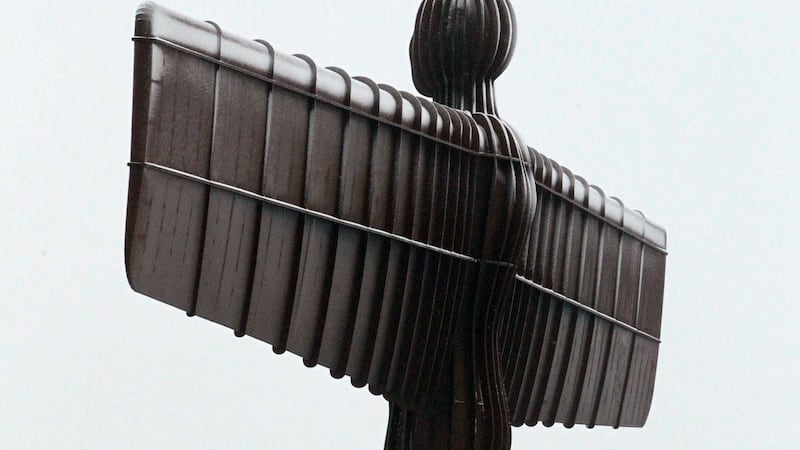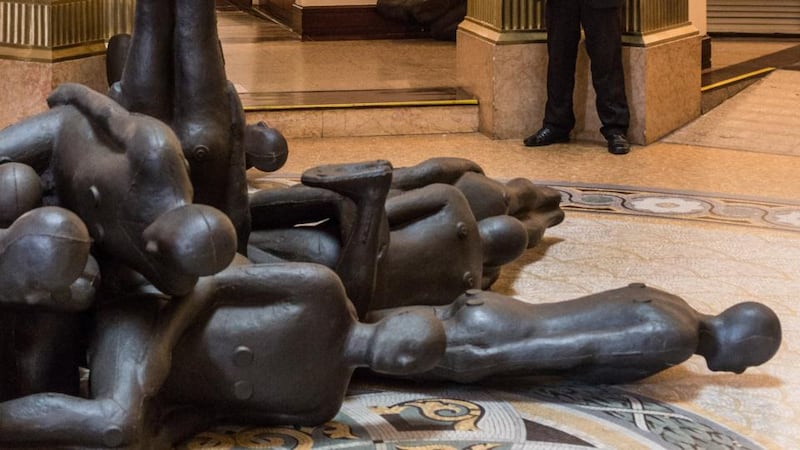He has the distinctly unbohemian bearing and manner of a distracted academic, complete with wire-rimmed glasses, but Antony Gormley is one of the busiest and most famous contemporary artists in the world.
His Angel of the North near Gateshead is a landmark monument. His high-profile installations in cities and rural settings continue to attract headlines and comment around the globe, not just from within the art world, but from the general public. He is exceptionally tall and slim with dark, close-cropped hair. He is a youthful 65. The scale, number and complexity of his current projects beggar belief. If anyone has a right to be distracted, he does.
He is in Ireland to deliver the winter lecture at the Irish Museum of Modern Art, which is the annual closing event of Imma's talks programme. Demand for tickets is such that the venue has had to be switched from the chapel to the roomier banqueting hall.


In 1991, early in his career, Gormley was one of the artists included in Imma’s inaugural exhibition. And he had a major solo show there in 1994, organised in conjunction with Tate Liverpool and the Malmo Konsthall. He was pleased by the reception he received at the time.
Does he still like Ireland? “I love Ireland,” he says. “I love that it’s full of interesting people, kind people, people who have a different attitude to time. I’ve read that the Celtic Tiger is now a Celtic Mule or something, but I hope people haven’t lost their love of company and craic.”
Gormley’s paternal grandfather was a Catholic from Derry who settled in Walsall and married an English woman. His father retained his Catholicism and his Irish heritage but married a German physiotherapist. She became a Catholic. They lived in quite a cosmopolitan, lively, intellectual milieu in Hampstead. Gormley was sent to Ampleforth, and then studied archaeology, anthropology and art history at the University Cambridge.
He was on course to become the academic he so resembles. Instead, interested in Buddhism, he travelled to India and Sri Lanka and studied Vipassana meditation, which has the aim of enabling practitioners "to see things as they really are". While at Cambridge, he befriended a number of artists, including Michael Craig Martin, and developed a sense of the contemporary artworld. Now, entirely removed from that world, he resolved to be an artist. More, he would be a sculptor.
“Sculpture is the most challenging and resilient of art forms. It is the greatest agent of change of all art forms.”
Rough, earthy quality
It is the materiality of sculpture that is vital to him. When he employs cast iron, he remarks, he thinks of it as earth, because it comes from the earth. There is a rough, earthy quality to almost everything he does. It is, as he sees it, rooted in the physical, but looks beyond it. “Sculpture demands the kind of engagement more than ever necessary in the digital age, when we are all looking at screens.”
Famously, Gormley’s own naked body, usually cast from life, is at the very heart of his work, which sounds like an extreme form of narcissism.
Not so, he says. We are embodied creatures – that is how we experience the world – and he is working from that premise. Rather than making a symbolic representation of a human figure, he is working with a physical trace of the figure, of himself.
He hopes that those who see his work will consider our position in the world, in nature and in the wider cosmos. For him, sculpture is “more process than thing. The thing is a byproduct.”
What is in a sense true of every work of art is expressly built, quantum-like, into his: it is not finished, not complete, until the spectator engages with it. It is sculpture’s inescapable, stubborn materiality, he suggests, that makes us consider our own materiality and ask what lies beyond it. Artists now routinely see themselves as social or political engineers, but they are much more wary about making metaphysical claims.
Gormley doesn’t hesitate, though, and he sees a combination of all these concerns as integral to what he’s trying to do.
“Sculpture by implication, because it can resist the elements, can take its place as part of the real world.” This facilitates “a return to social responsibility that art in the 20th century dismissed”, he argues.
That problem dates further back: “19th-century art was not so good at making imaginative additions to open spaces.” Public areas tended to be occupied by monumental statues of establishment figures, typically historical celebrities and usually patriarchal strongmen. “The 20th century refined that process to include objects.”
Romantic and exclusive
He has in mind here revered abstractions, as apart from the spectator as generals and viceroys towering on horseback. Even great 20th-century sculptors – Brancusi and Giacometti rate particularly highly with him – never needed to leave the studio. “Effectively the studio is their world, which is dangerously romantic and exclusive.”
His own decidedly unheroic figures may be as tough as iron but they are also “pathetic, naked not nude, and they don’t take their standing for granted”. They are, though, “aware, alert, erect, conscious of their own exposure, whether they are on the ground or on the roofs of buildings”. They are also very much at the mercy of the elements and the general public.
The public has on occasion dressed them with seasonal attire or, say, football colours, but they have been hardly vandalised, which is perhaps surprising. Unlike the generic heroic statue, which often seeks to put us in our place, his sculptures “are emptied of preordained function. They are an acknowledgment of subjectivity, not idealisations.”
Their combination of inertia and alertness is important. They usually look and direct our gaze towards the horizon, he says, but from within a quiet, reflective core: “the body as a place, not an object”.
From early on, Gormley leapfrogged from the studio to public spaces, never focusing his ambitions on success within the privileged domain of the gallery and museum. “I felt I didn’t need the blessing of institutional approval. I know you could say, ‘Well that was because you weren’t getting any’, but actually I was. I’ve been quite fortunate in that respect.”
The inner logic of his work meant that it should be out on the street or on the seashore or in the middle of the countryside, taking its chances in the real world.
Thinking outside the gallery has been phenomenally successful for him. Event Horizon had its first iteration in London in 2007, with 31 figures sited on buildings on the South Bank. The capacity of these life- cast sculptures to utterly transform the monumental urban setting for each individual observer was a revelation.
It's no wonder that other cities wanted to install Event Horizon. Since then, it has been in New York City, São Paulo and is currently in Hong Kong.
Gormley resists the notion that Event Horizon can be simply slotted into place in any city, but he really wanted to install it in Hong Kong. In the intervening time, he notes, seven or eight of the locations have shifted as the city has moved on.
As he sees it, the global financial centre is becoming more culturally self-aware and active. In this vertical domain, his figures are all the more effective, like Wim Wenders' winged angel poised over the city of Berlin in Wings of Desire.
He also has a major installation at Forte di Belvedere in Florence, five linked figures in Landmark Trust properties in the UK marking the organisation’s 50th anniversary, plus pieces at several other locations, not to mention the 100 figures that have been on Crosby Beach in Liverpool for 10 years now.
In progress is a commission for MIT- Harvard (a 12m-tall double helix: "My answer to Brancusi's Endless Column") and "our first pure carbon sculpture", a huge graphite piece for the Neils Bohr science department at the University of Copenhagen. All grist to the mill, but he is distracted partly because he's mulling over another offer one can't refuse: to create a work for a vast national park in Brazil.
At first there were so many factors and issues pressing on him that “I had not a clue what to do”. Now, following extensive research and reflection, he thinks “something might be possible”.
- Antony Gormley's Hold (1988) is on view as part of the exhibition Imma Collection: Approaches to Paper until April 3rd












